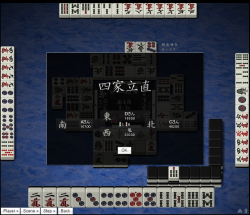Tochuu ryuukyoku: Difference between revisions
(noten riichi check on suucha riichi) |
m (→Consequences) |
||
| Line 13: | Line 13: | ||
Essentially, play resumes as if the previous hand did not occur, except with the additional honba count. | Essentially, play resumes as if the previous hand did not occur, except with the additional honba count. | ||
If the cause was due to four riichi calls (see below), all players must reveal their tenpai hands. Players without [[tenpai]] hands are punished with a [[chombo]] for declaring riichi while noten. | If the cause was due to four riichi calls (see below), all players must reveal their tenpai hands. Players without [[tenpai]] hands are punished with a [[chombo]] for declaring riichi while noten. After committing a chombo, the hand must be repeated, but no honba is added and all riichi declarers get one riichi stick back. | ||
== Causes == | == Causes == | ||
Revision as of 16:08, 8 October 2013
Tochuu ryuukoku (途中流局) is more commonly known as an abortive draw. Specific game situations end a kyoku (hand session) without any player declaring a win or drawing all tiles from the wall. With the exception of kyuushuu kyuuhai, all cases of tochuu ryuukoku are mandatory.
Consequences

In the event of tochuu ryuukoku, the current hand is instantly aborted. Furthermore:
- No points are exchanged between players; instead, the tiles are reshuffled again for the next hand.
- The noten penalty per exhaustive draw is not applied.
- Riichi declarers do not have to reveal their hand.
- All riichi bets remain on the table and can be won during the next hand.
- As with an exhaustive draw, the honba count increases by one.
- Finally, the seat winds do not rotate for the next hand.
Essentially, play resumes as if the previous hand did not occur, except with the additional honba count.
If the cause was due to four riichi calls (see below), all players must reveal their tenpai hands. Players without tenpai hands are punished with a chombo for declaring riichi while noten. After committing a chombo, the hand must be repeated, but no honba is added and all riichi declarers get one riichi stick back.
Causes
The following screnarios cause an abortive draw.
Suufon renta
The first discard of each player is the same wind tile.
Kyuushuu kyuuhai
A player's 14-tile hand after his initial draw is composed of 9 different honor or terminal tiles. The player may announce this and reveal his hand, then the hand is aborted. This option is only available if no tile call has interrupted the set of turns earlier. Instead of calling kyuushuu kyuuhai, a player may play the hand normally, maybe aiming for kokushi musou. This is the only case where the call for tochuu ryuukoku is optional.
Suucha riichi
All four players call riichi and the 4th player's discard is not a winning tile. All players have to reveal their tenpai hands, and noten riichis are punished with a chombo.
Suu kaikan
Kan is called four times by different players. If all four quads are called by one player, play continues as to give the player the opportunity to score the yakuman, suu kantsu. No other players are allowed to declare kan from then on. If the four quads have been formed by more than one player, hand abortion after formation of the fourth quad depends on the rules.
- Most rules abort the hand when the following discard is not a winning tile.
- Some rules end the game already on declaration of the fourth quad.
- Some rules may allow the game to go on, as if all quads had been declared by a single player. Usually, a fifth kan may not be declared at all, but when it is allowed, it immedeately aborts the game on its declaration.
Sanchahou
In some rules, if three players call ron on the same tile, the hand is aborted and no player wins.